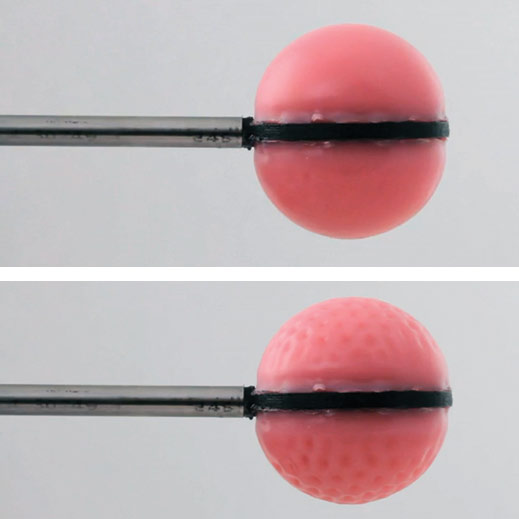“Smorphs”: Less of a Drag
There is a reason why golf balls have that dimpled surface, as do the latest soccer balls and even some athletic wear. Testing over the years has proved that such irregular surfaces, on round or blunt objects, dramatically cut the drag caused by air resistance and thus can increase speed.

Now MIT researchers have found a way to harness that effect to reduce drag on a variety of surfaces.
Aerodynamics studies have shown that while a ball with a dimpled surface has half the drag of a smooth one at lower speeds, it has more drag than a smooth surface at higher speeds. So the ideal would be a surface whose roughness can be altered, literally, on the fly—and that’s what the team led by Pedro Reis, a professor of mechanical engineering and civil and environmental engineering, has developed.
To get surfaces that could change in real time, the researchers imitated the multilayer configuration that causes smooth plums to dry into wrinkly prunes. Reis and his team made a hollow ball of soft material enveloped by a stiff skin, both layers made of rubberlike materials. Then they extracted air from the hollow interior to make the ball shrink, causing its surface to wrinkle.
When the researchers saw the wrinkled outcomes of initial tests with their multilayer spheres, “we realized that these samples look just like golf balls,” Reis says. “We systematically tested them in a wind tunnel, and we saw a reduction in drag very similar to that of golf balls.”
Because the surface texture can be controlled by adjusting the balls’ interior pressure, the degree of drag reduction can be controlled at will. “We can generate that surface topography or erase it,” Reis says. “That reversibility is why this is pretty interesting; you can switch the drag-reducing effect on and off, and tune it.”
The team refers to its invention as “smart morphable surfaces”—or “smorphs.” The pun is intentional, Reis says: the paper’s lead author—former postdoc Denis Terwagne, a fan of Belgian comics—pointed out that one characteristic of the Smurfs cartoon characters is that no matter how old they get, they never develop wrinkles.
One possible application could be in automobiles: adjusting the texture of exterior panels to minimize drag at different speeds could increase fuel efficiency, Reis says.
Keep Reading
Most Popular
Large language models can do jaw-dropping things. But nobody knows exactly why.
And that's a problem. Figuring it out is one of the biggest scientific puzzles of our time and a crucial step towards controlling more powerful future models.
The problem with plug-in hybrids? Their drivers.
Plug-in hybrids are often sold as a transition to EVs, but new data from Europe shows we’re still underestimating the emissions they produce.
Google DeepMind’s new generative model makes Super Mario–like games from scratch
Genie learns how to control games by watching hours and hours of video. It could help train next-gen robots too.
How scientists traced a mysterious covid case back to six toilets
When wastewater surveillance turns into a hunt for a single infected individual, the ethics get tricky.
Stay connected
Get the latest updates from
MIT Technology Review
Discover special offers, top stories, upcoming events, and more.